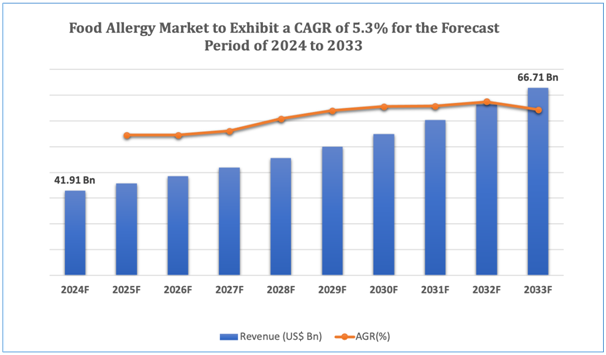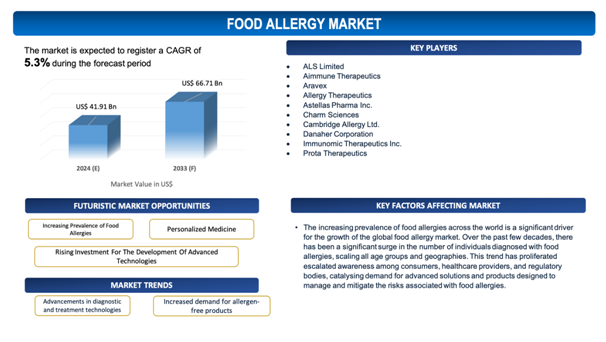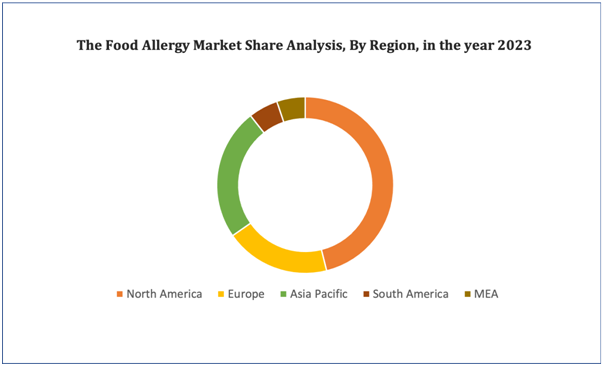Food Allergy Market Overview
The global food allergy market is estimated to be worth over USD 66.71Bn in 2033 and is expected to grow at CAGR of 5.3% during the forecast period (2024-2033).
Food allergies have become a major health concern across the world, primarilyredefining the outlook of dietary preferences, food labeling regulations, and hospitality practices. Outlined as adverse immune responses triggered by specific proteins in food, food allergies impact individuals across all age groups, with symptoms scaling from mild itching to serious anaphylaxis, which can be life-threatening. The prevalence of food allergies is on the surge, especially in developed countries, where stringent reporting and diagnostic methods underscore the increasing numbers affected.
This rise in food allergies has inducedextensive changes in how food is produced, prepared, and served. Restaurants and food manufacturers now face escalated scrutiny regarding ingredient sourcing and cross-contamination prevention. Labeling laws have evolved to comprise clearer indications of allergens, helping consumers in making informed alternatives and mitigating accidental exposure. The foodservice industry has adapted by offering allergen-free menus and staff training to handle allergy-associated emergencies effectively.
Socially, food allergies have fostered a higher awareness of dietary inclusivity and accommodation. Workplaces, schools, and public venues implement policies to protect individuals with allergies, influencing social norms around shared meals and communal eating. This cultural move towards allergen awareness encourages empathy and support for those managing food allergies, supporting a more inclusive dining environment.
Technological developments have also held an essential role in administering food allergies, with advancements in allergen detection techniques and the proliferation of allergen-free substitutes improving food diversity and safety. Research into immunotherapy and genetic predispositions offers commitment for future treatments and preventative measures.
Thus, the increase of food allergies is redefining how societies approach food production, consumption, and social interactions. By fostering awareness, innovation, and inclusivity, this revolutionfocusesonreducing risks and improve the quality of life for individuals managing food allergies globally.
Figure 1. Food Allergy : Market Size

Get more details on this report - Request Free Sample
Key Market Insights
The global food allergy market is witnessingrobust growth fuelled by increasing prevalence rates and growing awareness among consumers and healthcare professionals. Significant developments comprisedevelopments in allergen detection technologies such as swift testing kits and molecular diagnostics, which allow quicker and more precise identification of allergens in food products. These innovations are crucial for food manufacturers to comply with stringent labeling regulations and ensure safety for allergic consumers.
Novel technologies are also emerging in the form of allergen-free food alternatives, comprising plant-based proteins and genetically modified organisms designed to eliminate allergenic proteins. Such advancements not only cater to the increasing demand for allergen-free products but also expand dietary alternatives for individuals with allergies.
The market panorama is further defined by regulatory initiatives focused at improving allergen management practices in food production and foodservice industries worldwide. These regulations mandate comprehensive labeling practices and allergen risk assessment protocols to protect allergic consumers.
In terms of market dynamics, North America and Europe dominate the global food allergy market due to higher prevalence rates and robust healthcare infrastructure supporting allergy management. Regardless, swift urbanization and dietary changes in emerging economies are estimated to fuel market growth in Asia-Pacific and Latin America in the forthcoming years.
Overall, the global food allergy market is characterized by technological developments, regulatory developments, and increasing consumer awareness, creating opportunities for innovation and market expansion in allergen management and allergen-free food products.
Market Dynamics
Market Drivers
Growing Prevalence of Food Allergies Worldwide
The increasing prevalence of food allergies across the world is a significant driver for the growth of the global food allergy market. Over the past few decades, there has been a significantsurge in the number of individuals diagnosed with food allergies, scaling all age groups and geographies. This trend has proliferatedescalated awareness among consumers, healthcare providers, and regulatory bodies, catalysing demand for advanced solutions and products designed to manage and mitigate the risks associated with food allergies.
From a market perspective, the growing prevalence of food allergies has resulted in expanded opportunities for allergen testing and detection technologies. Manufacturers are investing in the development of swift and precise diagnostic tools that can identify allergens in food products, ensuring compliance with stringent labelling regulations and improving consumer safety.
In addition, the growing incidence of food allergies has spurred growth in the allergen-free food market. Companies are innovating to create allergen-free alternatives and substitutes, comprisinggluten-free, dairy-free, and nut-free products, to cater to the dietary needs of allergic consumers. This diversification of product offerings not only fulfils the demand for safe food choices but also expands market reach and revenue potential.
Moreover, the prevalence of food allergies drives investment in research and development for novel treatments and therapies focused at managing allergic reactions effectively. This comprisesdevelopments in immunotherapy and allergen desensitization techniques, providing commitment for enhanced quality of life for individuals living with food allergies.
In conclusion, the surge in prevalence of food allergies serves as a crucial market driver, spurring innovation, regulatory action, and consumer demand across the global food allergy market. As awareness continues to spur, so too will opportunities for technological advancements and product development aimed at addressing this worldwide health concern.
Market Restraints
With regard to numerous advantages of Food Allergy , the market faces several challenges due to the unique characteristics and requirements associated with these potent pharmaceutical products. Some of the key market challenges include:
- High Cost of Allergen-Free Products: Allergen-free products, such as gluten-free or nut-free alternatives, often incur higher production costs owing to specialized ingredients, separate production facilities, and stringent quality control measures. This heightened cost can hinder affordability and accessibility for some consumers, especially in regions with lower income levels or less developed healthcare systems.
- Complex Regulatory Landscape: The global food allergy market is subject to complex and evolving regulatory frameworks governing allergen labeling, safety standards, and claims verification. Compliance with these regulations requires significant investment in research, testing, and administrative processes, which can pose barriers to entry for smaller manufacturers and start-ups. In addition, changing regulatory requirements across diverse regions and countries add to the intricacy and operational challenges for multinational companies seeking to enter new markets. This regulatory diversity can also result in inconsistencies in allergen management practices and consumer confusion regarding product safety and labeling standards.

Get more details on this report - Request Free Sample
Market Opportunity
Rising Investment For The Development Of Advanced Technologies
Increasing investment in the development of advanced technologies stands as a notable market opportunity for the global food allergy market. These investments are accelerating innovations that enhance the diagnosis, management, and treatment of food allergies, acknowledging a crucial and soaring health concern. Modern diagnostic tools, such as component-resolved diagnostics and next-generation sequencing, provide more accurate identification of allergenic proteins and the potential for personalized allergy profiles. This accuracyallowsimproved patient management and targeted therapies, minimizing the risk of severe allergic reactions.
In the sphere of treatment, investments in immunotherapy are leading to promising developments. Techniques like oral immunotherapy (OIT) and epicutaneous immunotherapy (EPIT) are being refined and tested, reflecting potential to desensitize individuals to specific allergens and reduce the severity of allergic responses. These innovations could revolutionize the therapeutic panorama, offering long-term solutions beyond symptomatic relief.
The food industry also benefits from technological investments, with advancements in allergen detection and labelling. Improved food safety protocols and the development of allergen-free products cater to the soaring demand for safe food options, expanding market opportunities. Companies investing in these technologies can capture a loyal customer base seeking reliable and safe food choices.
Additionally, digital health technologies, comprising mobile apps and wearable devices, are evolving as valuable tools for individuals with food allergies. These technologies offerallergen tracking, real-time information, and emergency response capabilities, enhancing day-to-day management and safety.
All in all, the inflow of investments in advanced technologies fosters a dynamic and developing market for food allergy solutions, improving patient care, expanding product offerings, and fuelling industry growth.
Top of Form
Bottom of Form
Market Trends
- Increased Demand for Allergen-Free Products: There is an increasing consumer demand for allergen-free food products as awareness of food allergies surges. This trend has led food manufacturers to advance and develop aextensivescale of allergen-free alternatives, such as dairy-free, gluten-free, and nut-free products. The greater availability of these alternatives is catering to the dietary needs of allergic individuals and expanding the market for safe and inclusive food choices.
- Advancements in Diagnostic and Treatment Technologies: The global food allergy market is experiencingnotabledevelopments in both diagnostic and treatment technologies. Improved diagnostic tools, like component-resolved diagnostics, offer more precise identification of specific allergenic proteins, resulting inimproved management strategies. On the treatment front, developments in immunotherapy, such as oral immunotherapy (OIT) and epicutaneous immunotherapy (EPIT), are reflecting promise in desensitizing individuals to allergens, potentially minimizing the severity of allergic reactions. These technological breakthroughs are revolutionizing patient care and boosting growth in the food allergy market.
Food Allergy Market: Key Segments
By Allergen Source
- Gluten
- Peanut
- Mustard
- Milk
- Egg
- Fish
- Others
By Treatment
- Antihistamines
- Adrenaline
- Oral Immunotherapy
- Others
By End Use
- Clinics
- Hospitals
- Ambulatory Surgery Centres
By Key Geographical Regions
- North America
- Europe
- Asia-Pacific
- Middle East and Africa
- South America
Figure 4. Food Allergy Market: Distribution by Region

Get more details on this report - Request Free Sample
Food Allergy Market: Regional Analysis
North America is likely to account for a dominating share of global food allergy treatments. Several factors are responsible for this dominance, comprising a large number of patients, advancements in food allergy treatment, and a high level of awareness regarding food allergies and treatment.The development of new food allergy treatments and the development of new drugs in the USA market will further widen the market for food allergy treatments. As a result of the recent approval of oral immunotherapy (OIT) by the Food and Drug Administration (FDA), patients with peanut allergies can now benefit from this treatment, while patients with mild reactions are not suitable for this treatment.
Leading Food Allergy Developers
Industry Trends and Global Forecasts, 2023-2035 report features an extensive study of the current market landscape, market size and future opportunities associated with the Food Allergy market, during the given forecast period. Further, the market report highlights the efforts of several stakeholders engaged in this rapidly emerging segment of the biopharmaceutical industry. Key takeaways of the Food Allergy market are briefly discussed below.
The report includes the list of players operating in the global Food Allergy market. Some of the key players include:
- ALS Limited
- Aimmune Therapeutics
- Aravex
- Allergy Therapeutics
- Astellas Pharma Inc.
- Charm Sciences
- Cambridge Allergy Ltd.
- Danaher Corporation
- Immunomic Therapeutics Inc.
- Prota Therapeutics
Food Allergy Market: Key Developments
- In February 2024, the U.S. Food and Drug Administration approved Xolair (omalizumab) injection for immunoglobulin E-mediated food allergy in certain adults and children 1 year or older for the reduction of allergic reactions (Type I), including reducing the risk of anaphylaxis, that may occur with accidental exposure to one or more foods.
Scope of the Report
The market report presents an in-depth analysis of the various firms / organizations that are engaged in this market, across different segments, as defined in the below table:
|
|
Key Report Attributes |
Details |
||
|
|
Base Year |
2023 |
||
|
|
Forecast Period |
2024-2033 |
||
|
|
CAGR (2024-2033) |
5.3% |
||
|
|
Allergen Source |
|
||
|
|
Treatment |
|
||
|
|
End Use |
|
||
|
|
Key Geographical Regions |
|
||
|
Key Companies Profiled |
|
|
||
